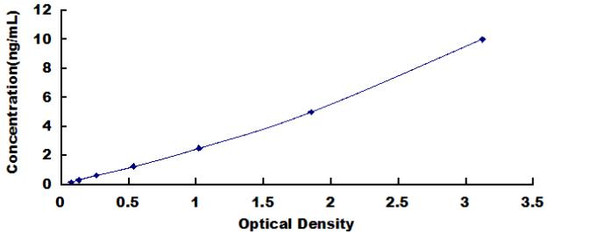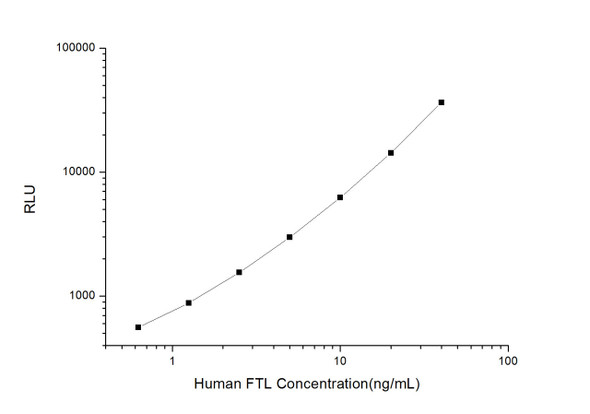Human Cell Biology ELISA Kits 1
Human FTL (Ferritin, Light Polypeptide) ELISA Kit (HUES02939)
- SKU:
- HUES02939
- Product Type:
- ELISA Kit
- Size:
- 96 Assays
- Uniprot:
- P02792
- Sensitivity:
- 1.88ng/mL
- Range:
- 3.13-200ng/mL
- ELISA Type:
- Sandwich
- Synonyms:
- NBIA3, Ferritin Light Chain
- Reactivity:
- Human
- Sample Type:
- Serum, plasma and other biological fluids
- Research Area:
- Cell Biology
Description
| Assay type: | Sandwich |
| Format: | 96T |
| Assay time: | 4.5h |
| Reactivity: | Human |
| Detection Method: | Colormetric |
| Detection Range: | 3.13-200 ng/mL |
| Sensitivity: | 1.88 ng/mL |
| Sample Volume Required Per Well: | 100µL |
| Sample Type: | Serum, plasma and other biological fluids |
| Specificity: | This kit recognizes Human FTL in samples. No significant cross-reactivity or interference between Human FTL and analogues was observed. |
This ELISA kit uses Sandwich-ELISA as the method. The micro ELISA plate provided in this kit has been pre-coated with an antibody specific to Human FTL. Standards or samples are added to the appropriate micro ELISA plate wells and combined with the specific antibody. Then a biotinylated detection antibody specific for Human FTL and Avidin-Horseradish Peroxidase (HRP) conjugate are added to each micro plate well successively and incubated. Free components are washed away. The substrate solution is added to each well. Only those wells that contain Human FTL, biotinylated detection antibody and Avidin-HRP conjugate will appear blue in color. The enzyme-substrate reaction is terminated by adding Stop Solution and the color turns yellow. The optical density (OD) is measured spectrophotometrically at a wavelength of 450 nm ± 2 nm. The OD value is proportional to the concentration of Human FTL. The concentration of Human FTL in samples can be calculated by comparing the OD of the samples to the standard curve.
| UniProt Protein Function: | FTL: Stores iron in a soluble, non-toxic, readily available form. Important for iron homeostasis. Iron is taken up in the ferrous form and deposited as ferric hydroxides after oxidation. Also plays a role in delivery of iron to cells. Mediates iron uptake in capsule cells of the developing kidney. Defects in FTL are the cause of hereditary hyperferritinemia-cataract syndrome (HHCS). It is an autosomal dominant disease characterized by early-onset bilateral cataract. Affected patients have elevated level of circulating ferritin. HHCS is caused by mutations in the iron responsive element (IRE) of the FTL gene. Defects in FTL are the cause of neurodegeneration with brain iron accumulation type 3 (NBIA3); also known as adult-onset basal ganglia disease. It is a movement disorder with heterogeneous presentations starting in the fourth to sixth decade. It is characterized by a variety of neurological signs including parkinsonism, ataxia, corticospinal signs, mild nonprogressive cognitive deficit and episodic psychosis. It is linked with decreased serum ferritin levels. Belongs to the ferritin family. |
| UniProt Protein Details: | Protein type:Oxidoreductase Chromosomal Location of Human Ortholog: 19q13. 33 Cellular Component: ferritin complex; membrane; cytosol Molecular Function:identical protein binding; protein binding; ferric iron binding; iron ion binding Biological Process: receptor-mediated endocytosis; iron ion homeostasis; cellular iron ion homeostasis; post-Golgi vesicle-mediated transport; iron ion transport; transmembrane transport Disease: Hyperferritinemia With Or Without Cataract; L-ferritin Deficiency; Neurodegeneration With Brain Iron Accumulation 3 |
| NCBI Summary: | This gene encodes the light subunit of the ferritin protein. Ferritin is the major intracellular iron storage protein in prokaryotes and eukaryotes. It is composed of 24 subunits of the heavy and light ferritin chains. Variation in ferritin subunit composition may affect the rates of iron uptake and release in different tissues. A major function of ferritin is the storage of iron in a soluble and nontoxic state. Defects in this light chain ferritin gene are associated with several neurodegenerative diseases and hyperferritinemia-cataract syndrome. This gene has multiple pseudogenes. [provided by RefSeq, Jul 2008] |
| UniProt Code: | P02792 |
| NCBI GenInfo Identifier: | 120523 |
| NCBI Gene ID: | 2512 |
| NCBI Accession: | P02792. 2 |
| UniProt Secondary Accession: | P02792,Q6IBT7, Q7Z2W1, Q86WI9, Q8WU07, Q96AU9, Q96CU0 Q9BTZ8, B2R4B9, |
| UniProt Related Accession: | P02792 |
| Molecular Weight: | 440 kDa |
| NCBI Full Name: | Ferritin light chain |
| NCBI Synonym Full Names: | ferritin, light polypeptide |
| NCBI Official Symbol: | FTL |
| NCBI Official Synonym Symbols: | LFTD; NBIA3 |
| NCBI Protein Information: | ferritin light chain; ferritin L-chain; ferritin L subunit; ferritin light polypeptide-like 3 |
| UniProt Protein Name: | Ferritin light chain |
| Protein Family: | Ferritin |
| UniProt Gene Name: | FTL |
| UniProt Entry Name: | FRIL_HUMAN |
As the OD values of the standard curve may vary according to the conditions of the actual assay performance (e. g. operator, pipetting technique, washing technique or temperature effects), the operator should establish a standard curve for each test. Typical standard curve and data is provided below for reference only.
| Concentration (ng/mL) | O.D | Average | Corrected |
| 200 | 2.271 2.295 | 2.283 | 2.196 |
| 100 | 1.393 1.425 | 1.409 | 1.322 |
| 50 | 0.813 0.783 | 0.798 | 0.711 |
| 25 | 0.419 0.449 | 0.434 | 0.347 |
| 12.5 | 0.242 0.22 | 0.231 | 0.144 |
| 6.25 | 0.183 0.163 | 0.173 | 0.086 |
| 3.13 | 0.132 0.134 | 0.133 | 0.046 |
| 0 | 0.083 0.091 | 0.087 | -- |
Precision
Intra-assay Precision (Precision within an assay): 3 samples with low, mid range and high level Human FTL were tested 20 times on one plate, respectively.
Inter-assay Precision (Precision between assays): 3 samples with low, mid range and high level Human FTL were tested on 3 different plates, 20 replicates in each plate.
| Intra-assay Precision | Inter-assay Precision | |||||
| Sample | 1 | 2 | 3 | 1 | 2 | 3 |
| n | 20 | 20 | 20 | 20 | 20 | 20 |
| Mean (ng/mL) | 9.21 | 20.09 | 96.80 | 8.67 | 19.28 | 89.09 |
| Standard deviation | 0.49 | 0.91 | 3.48 | 0.48 | 1.06 | 3.64 |
| C V (%) | 5.32 | 4.53 | 3.60 | 5.54 | 5.50 | 4.09 |
Recovery
The recovery of Human FTL spiked at three different levels in samples throughout the range of the assay was evaluated in various matrices.
| Sample Type | Range (%) | Average Recovery (%) |
| Serum (n=5) | 85-100 | 92 |
| EDTA plasma (n=5) | 86-100 | 92 |
| Cell culture media (n=5) | 91-106 | 98 |
Linearity
Samples were spiked with high concentrations of Human FTL and diluted with Reference Standard & Sample Diluent to produce samples with values within the range of the assay.
| Serum (n=5) | EDTA plasma (n=5) | Cell culture media (n=5) | ||
| 1:2 | Range (%) | 96-112 | 87-99 | 98-112 |
| Average (%) | 103 | 92 | 106 | |
| 1:4 | Range (%) | 88-99 | 85-100 | 82-96 |
| Average (%) | 93 | 91 | 89 | |
| 1:8 | Range (%) | 92-108 | 88-102 | 85-97 |
| Average (%) | 99 | 93 | 91 | |
| 1:16 | Range (%) | 93-106 | 83-94 | 83-94 |
| Average (%) | 99 | 87 | 88 |
An unopened kit can be stored at 4°C for 1 month. If the kit is not used within 1 month, store the items separately according to the following conditions once the kit is received.
| Item | Specifications | Storage |
| Micro ELISA Plate(Dismountable) | 8 wells ×12 strips | -20°C, 6 months |
| Reference Standard | 2 vials | |
| Concentrated Biotinylated Detection Ab (100×) | 1 vial, 120 µL | |
| Concentrated HRP Conjugate (100×) | 1 vial, 120 µL | -20°C(shading light), 6 months |
| Reference Standard & Sample Diluent | 1 vial, 20 mL | 4°C, 6 months |
| Biotinylated Detection Ab Diluent | 1 vial, 14 mL | |
| HRP Conjugate Diluent | 1 vial, 14 mL | |
| Concentrated Wash Buffer (25×) | 1 vial, 30 mL | |
| Substrate Reagent | 1 vial, 10 mL | 4°C(shading light) |
| Stop Solution | 1 vial, 10 mL | 4°C |
| Plate Sealer | 5 pieces | |
| Product Description | 1 copy | |
| Certificate of Analysis | 1 copy |
- Set standard, test sample and control (zero) wells on the pre-coated plate and record theirpositions. It is recommended to measure each standard and sample in duplicate. Note: addall solutions to the bottom of the plate wells while avoiding contact with the well walls. Ensuresolutions do not foam when adding to the wells.
- Aliquot 100µl of standard solutions into the standard wells.
- Add 100µl of Sample / Standard dilution buffer into the control (zero) well.
- Add 100µl of properly diluted sample (serum, plasma, tissue homogenates and otherbiological fluids) into test sample wells.
- Cover the plate with the sealer provided in the kit and incubate for 90 min at 37°C.
- Aspirate the liquid from each well, do not wash. Immediately add 100µL of BiotinylatedDetection Ab working solution to each well. Cover the plate with a plate seal and gently mix. Incubate for 1 hour at 37°C.
- Aspirate or decant the solution from the plate and add 350µL of wash buffer to each welland incubate for 1-2 minutes at room temperature. Aspirate the solution from each well andclap the plate on absorbent filter paper to dry. Repeat this process 3 times. Note: a microplatewasher can be used in this step and other wash steps.
- Add 100µL of HRP Conjugate working solution to each well. Cover with a plate seal andincubate for 30 min at 37°C.
- Aspirate or decant the solution from each well. Repeat the wash process for five times asconducted in step 7.
- Add 90µL of Substrate Reagent to each well. Cover with a new plate seal and incubate forapproximately 15 min at 37°C. Protect the plate from light. Note: the reaction time can beshortened or extended according to the actual color change, but not by more than 30min.
- Add 50 µL of Stop Solution to each well. Note: Adding the stop solution should be done inthe same order as the substrate solution.
- Determine the optical density (OD value) of each well immediately with a microplate readerset at 450 nm.






